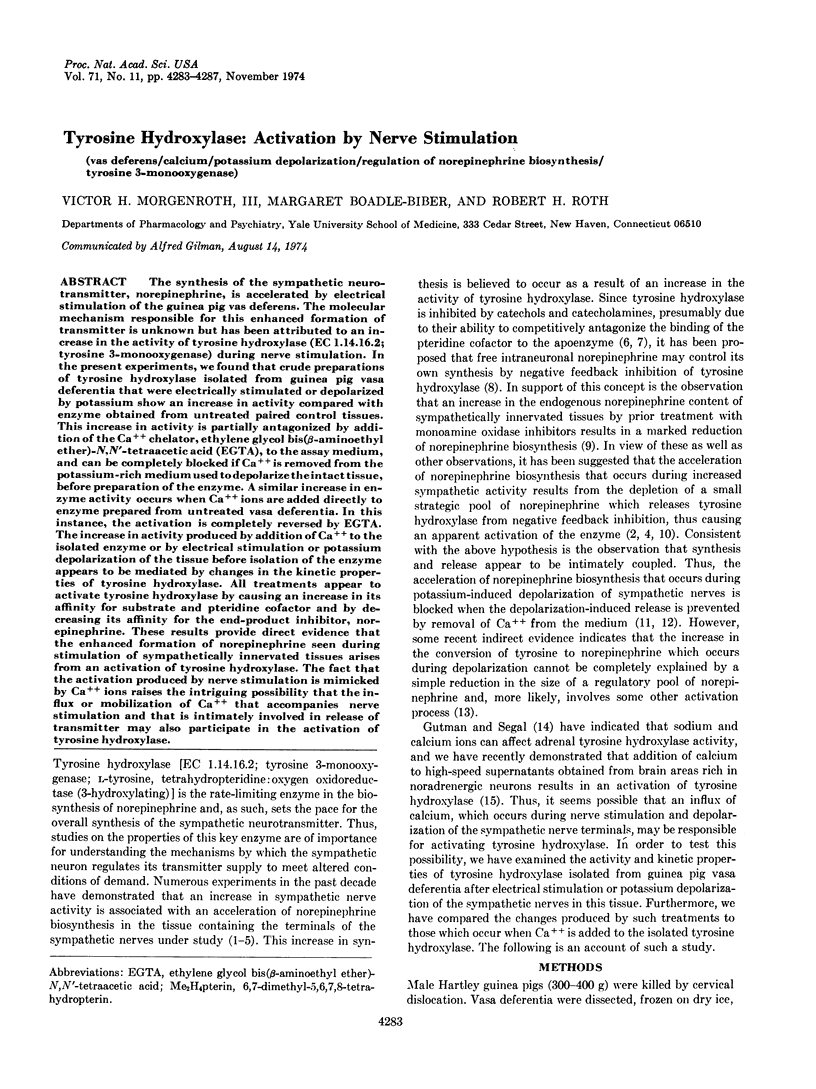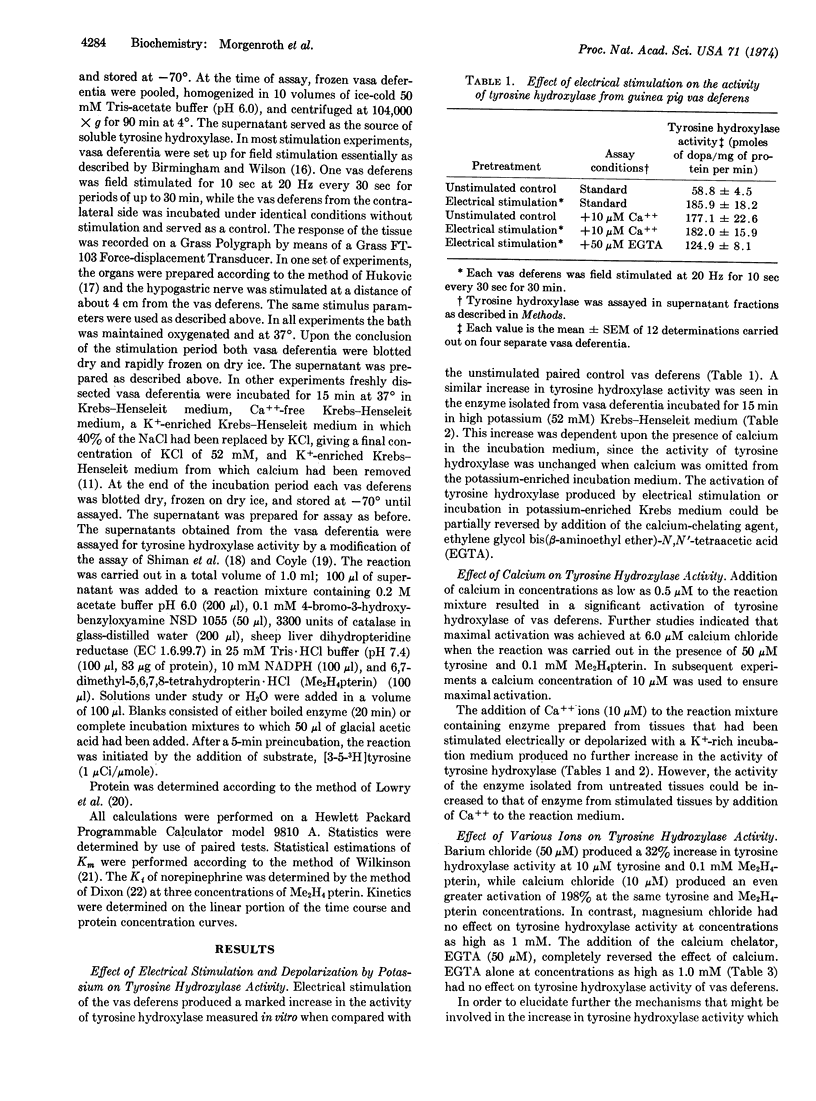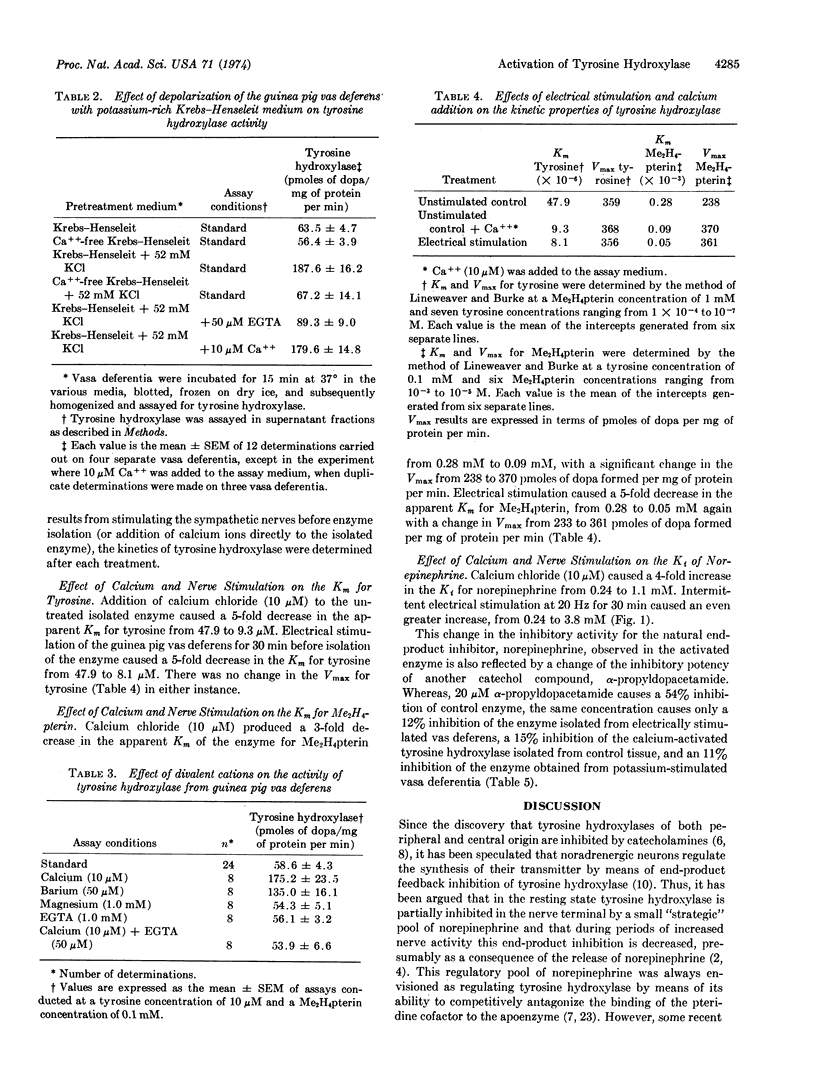Abstract
The synthesis of the sympathetic neurotransmitter, norepinephrine, is accelerated by electrical stimulation of the guinea pig vas deferens. The molecular mechanism responsible for this enhanced formation of transmitter is unknown but has been attributed to an increase in the activity of tyrosine hydroxylase (EC 1.14.16.2; tyrosine 3-monooxygenase) during nerve stimulation. In the present experiments, we found that crude preparations of tyrosine hydroxylase isolated from guinea pig vasa deferentia that were electrically stimulated or depolarized by potassium show an increase in activity compared with enzyme obtained from untreated paired control tissues. This increase in activity is partially antagonized by addition of the Ca++ chelator, ethylene glycol bis(β-aminoethyl ether)-N,N′-tetraacetic acid (EGTA), to the assay medium, and can be completely blocked if Ca++ is removed from the potassium-rich medium used to depolarize the intact tissue, before preparation of the enzyme. A similar increase in enzyme activity occurs when Ca++ ions are added directly to enzyme prepared from untreated vasa deferentia. In this instance, the activation is completely reversed by EGTA. The increase in activity produced by addition of Ca++ to the isolated enzyme or by electrical stimulation or potassium depolarization of the tissue before isolation of the enzyme appears to be mediated by changes in the kinetic properties of tyrosine hydroxylase. All treatments appear to activate tyrosine hydroxylase by causing an increase in its affinity for substrate and pteridine cofactor and by decreasing its affinity for the end-product inhibitor, norepinephrine. These results provide direct evidence that the enhanced formation of norepinephrine seen during stimulation of sympathetically innervated tissues arises from an activation of tyrosine hydroxylase. The fact that the activation produced by nerve stimulation is mimicked by Ca++ ions raises the intriguing possibility that the influx or mobilization of Ca++ that accompanies nerve stimulation and that is intimately involved in release of transmitter may also participate in the activation of tyrosine hydroxylase.
Keywords: vas deferens, calcium, potassium depolarization, regulation of norepinephrine biosynthesis, tyrosine 3-monooxygenase
Full text
PDF




Selected References
These references are in PubMed. This may not be the complete list of references from this article.
- Alousi A., Weiner N. The regulation of norepinephrine synthesis in sympathetic nerves: effect of nerve stimulation, cocaine, and catecholamine-releasing agents. Proc Natl Acad Sci U S A. 1966 Nov;56(5):1491–1496. doi: 10.1073/pnas.56.5.1491. [DOI] [PMC free article] [PubMed] [Google Scholar]
- BIRMINGHAM A. T., WILSON A. B. PREGANGLIONIC AND POSTGANGLIONIC STIMULATION OF THE GUINEA-PIG ISOLATED VAS DEFERENS PREPARATION. Br J Pharmacol Chemother. 1963 Dec;21:569–580. doi: 10.1111/j.1476-5381.1963.tb02024.x. [DOI] [PMC free article] [PubMed] [Google Scholar]
- Boadle-Biber M. C., Hughes J., Roth R. H. Acceleration of noradrenaline biosynthesis in the guinea-pig vas deferens by potassium. Br J Pharmacol. 1970 Dec;40(4):702–720. doi: 10.1111/j.1476-5381.1970.tb10648.x. [DOI] [PMC free article] [PubMed] [Google Scholar]
- Boadle-Biber M. C., Roth R. H. Effect of drugs on the synthesis of noradrenaline in guinea-pig vas deferens. Br J Pharmacol. 1972 Dec;46(4):696–707. doi: 10.1111/j.1476-5381.1972.tb06894.x. [DOI] [PMC free article] [PubMed] [Google Scholar]
- Cloutier G., Weiner N. Further studies on the increased synthesis of norepinephrine during nerve stimulation of guinea-pig vas deferens preparation: effect of tyrosine and 6, 7-dimethyltetrahydropterin. J Pharmacol Exp Ther. 1973 Jul;186(1):75–85. [PubMed] [Google Scholar]
- Coyle J. T. Tyrosine hydroxylase in rat brain--cofactor requirements, regional and subcellular distribution. Biochem Pharmacol. 1972 Jul 15;21(14):1935–1944. doi: 10.1016/0006-2952(72)90006-8. [DOI] [PubMed] [Google Scholar]
- DIXON M. The determination of enzyme inhibitor constants. Biochem J. 1953 Aug;55(1):170–171. doi: 10.1042/bj0550170. [DOI] [PMC free article] [PubMed] [Google Scholar]
- Gordon R., Reid J. V., Sjoerdsma A., Udenfriend S. Increased synthesis of norepinephrine in the rat heart on electrical stimulation of the stellate ganglia. Mol Pharmacol. 1966 Nov;2(6):610–613. [PubMed] [Google Scholar]
- Gutman Y., Segal J. Effect of calcium, sodium and potassium on adrenal tyrosine hydroxylase activity in vitro. Biochem Pharmacol. 1972 Oct 1;21(19):2664–2666. doi: 10.1016/0006-2952(72)90239-0. [DOI] [PubMed] [Google Scholar]
- Ikeda M., Fahien L. A., Udenfriend S. A kinetic study of bovine adrenal tyrosine hydroxylase. J Biol Chem. 1966 Oct 10;241(19):4452–4456. [PubMed] [Google Scholar]
- NAGATSU T., LEVITT M., UDENFRIEND S. TYROSINE HYDROXYLASE. THE INITIAL STEP IN NOREPINEPHRINE BIOSYNTHESIS. J Biol Chem. 1964 Sep;239:2910–2917. [PubMed] [Google Scholar]
- Roth R. H., Stjärne L., von Euler U. S. Acceleration of noradrenaline biosynthesis by nerve stimulation. Life Sci. 1966 Jun;5(12):1071–1075. doi: 10.1016/0024-3205(66)90089-0. [DOI] [PubMed] [Google Scholar]
- Roth R. H., Stjärne L., von Euler U. S. Factors influencing the rate of norepinephrine biosynthesis in nerve tissue. J Pharmacol Exp Ther. 1967 Dec;158(3):373–377. [PubMed] [Google Scholar]
- Sedvall G. C., Kopin I. J. Acceleration of norepinephrine synthesis in the rat submaxillary gland in vivo during sympathetic nerve stimulation. Life Sci. 1967 Jan 1;6(1):45–51. doi: 10.1016/0024-3205(67)90360-8. [DOI] [PubMed] [Google Scholar]
- Shiman R., Akino M., Kaufman S. Solubilization and partial purification of tyrosine hydroxylase from bovine adrenal medulla. J Biol Chem. 1971 Mar 10;246(5):1330–1340. [PubMed] [Google Scholar]
- Spector S., Gordon R., Sjoerdsma A., Udenfriend S. End-product inhibition of tyrosine hydroxylase as a possible mechanism for regulation of norepinephrine synthesis. Mol Pharmacol. 1967 Nov;3(6):549–555. [PubMed] [Google Scholar]
- Stjärne L., Lishajko F., Roth R. H. Regulation of noradrenaline biosynthesis in nerve tissue. Nature. 1967 Aug 12;215(5102):770–772. doi: 10.1038/215770a0. [DOI] [PubMed] [Google Scholar]
- Udenfriend S., Zaltzman-Nirenberg P., Nagatsu T. Inhibitors of purified beef adrenal tyrosine hydroxylase. Biochem Pharmacol. 1965 May;14(5):837–845. doi: 10.1016/0006-2952(65)90103-6. [DOI] [PubMed] [Google Scholar]
- WILKINSON G. N. Statistical estimations in enzyme kinetics. Biochem J. 1961 Aug;80:324–332. doi: 10.1042/bj0800324. [DOI] [PMC free article] [PubMed] [Google Scholar]
- Weiner N., Rabadjija M. The effect of nerve stimulation on the synthesis and metabolism of norepinephrine in the isolated guinea-pig hypogastric nerve-vas deferens preparation. J Pharmacol Exp Ther. 1968 Mar;160(1):61–71. [PubMed] [Google Scholar]
- Weiner N. Regulation of norepinephrine biosynthesis. Annu Rev Pharmacol. 1970;10:273–290. doi: 10.1146/annurev.pa.10.040170.001421. [DOI] [PubMed] [Google Scholar]


